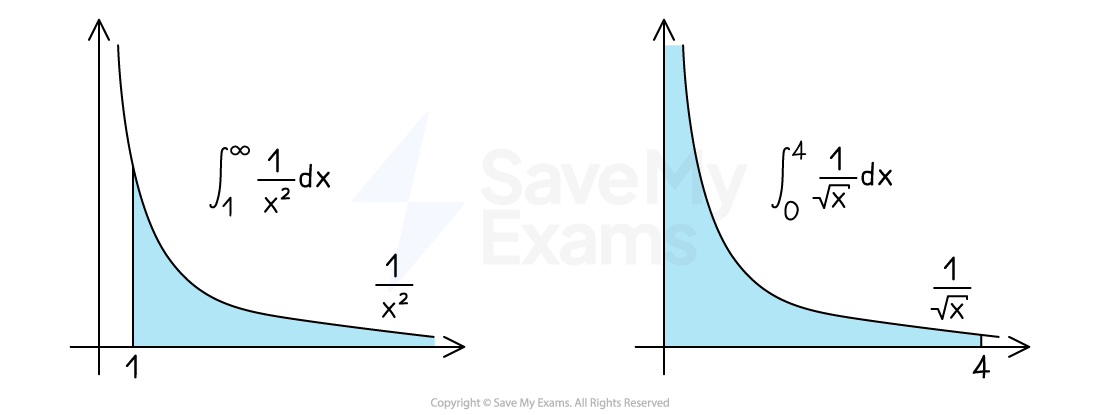Improper Integrals (College Board AP® Calculus BC): Study Guide
Evaluating improper integrals
What is an improper integral?
An improper integral is of the form
where
at least one of the limits of integration is infinite
or
is unbounded at a point in the interval
An improper integral can either converge to a limit or diverge

How do I evaluate an improper integral with infinite limits?
Case 1: One of the limits is infinite
or
STEP 1
Write the improper integral as a limitReplace the infinite limit of integration with a variable
Take the limit as that variable approaches the infinite limit
e.g.
STEP 2
Evaluate the definite integralIt will be an expression in terms of the newly introduced variable
e.g.
STEP 3
Find the value of the limit if it existse.g.
If the limit does not exist, the improper integral is divergent
Case 2: Both of the limits are infinite
STEP 1
Write the integral as a sum of two integralsChoose any value as the limit of integration where the two integrals 'meet'
e.g.
STEP 2
Write each integral as a limite.g.
Use a different limit variable for each integral
STEP 3
Evaluate each definite integrale.g.
STEP 4
Find the value of each limit and add them togethere.g.
If either of the limits does not exist, the improper integral is divergent
Worked Example
Show that the improper integral is divergent.
Answer:
STEP 1
Write the integral as a sum of two integrals
STEP 2
Write each integral as a limit
STEP 3
Evaluate each definite integral
STEP 4
Find the value of each limit and add them together
is divergent because
is not finite
How do I evaluate an improper integral with unbounded integrands?
Case 1: The function is unbounded at one of the endpoints
STEP 1
Write the improper integral as a limit by replacing the relevant limit of integration with a variableIf you are replacing the lower limit of integration, then take the limit as that variable approaches the original value from above
e.g.
If you are replacing the upper limit of integration, then take the limit as that variable approaches the original value from below
e.g.
STEP 2
Evaluate the definite integralIt will be an expression in terms of the newly introduced variable
e.g.
e.g.
STEP 3
Find the value of the limit if it existse.g.
If the limit does not exist, the improper integral is divergent
e.g.
so
is divergent
Case 2: The function is unbounded at a point in the interval (a, b)
STEP 1
Write the integral as a sum of two integralsUse the point of the essential discontinuity as the limit of integration where the two integrals 'meet'
e.g.
is unbounded at
so
STEP 2
Write each integral as a limite.g.
STEP 3
Evaluate each definite integrale.g.
STEP 4
Find the value of each limitIf both limits exist, add them together to find the limit of the improper integral
If either of the limits does not exist, the improper integral is divergent
e.g.
so
diverges
In this case
as well
But one unbounded limit is enough to show that the improper integral diverges
Examiner Tips and Tricks
Always check whether the function to be integrated is unbounded at any point in the interval. If you forget to check, you might end up with an incorrect answer that seems to work mathematically.
For example, you might incorrectly write
.
This is untrue due to the essential discontinuity at .
Examiner Tips and Tricks
Your first step should always be to write the improper integral as a limit of a definite integral. If you need to use a u-substitution when calculating the definite integral, then remember to change the limits of integration.
Worked Example
Evaluate or show that the integral diverges.
Answer:
The integrand is undefined when
STEP 1
Write the improper integral as a limit by replacing the relevant limit of integration with a variable
STEP 2
Evaluate the definite integral
Use the substitution and change the limits of integration
STEP 3
Find the value of the limit if it exists
Summary of improper integrals
The general approach is to write an improper integral as the limit of a definite integral
The table below shows the relevant limit to use
Reason for the improper integral | Limit of a definite integral |
|---|---|
The upper limit of integration is infinite | |
The lower limit of integration is infinite | |
Both limits of integration are infinite | For any value |
The integrand is unbounded at the upper limit of integration | |
The integrand is unbounded at the lower limit of integration | |
The integrand is unbounded at a point |

Unlock more, it's free!
Did this page help you?